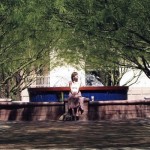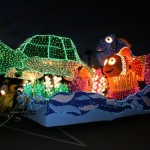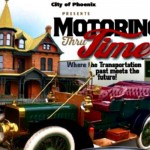A bustling downtown filled with pedestrians is a classic image for any vibrant city. Increased pedestrian traffic from the rise of ASU downtown, the growth of First and Third Fridays, and the impact of light rail have all invigorated our downtown neighborhoods, however walking in Phoenix can still be daunting. And many of us would agree that the single most important element to making Phoenix a truly great place for pedestrians is shade.
Shade wasn’t always so scarce in the Valley. From the late 19th century into the early 20th people tried growing every kind of tree in Phoenix and many took hold, either as crops (citrus, nuts) or providing shade in yards, along canals and lining streets.
Shade was everywhere, according to Edward Lebow’s book, Following the Water. “There is shade and plenty of it,” observed a visitor in 1905. “The entire valley, from Mesa into Phoenix, is one solid mass of green, and every road is a perfect avenue…the entire distance from Mesa to Phoenix can be driven under an almost unbroken arch of shade.”
WOW. Can you imagine? Clearly times have changed.
Increasingly, everyone recognizes the importance of shade in helping to create a vibrant downtown. Over the last five years various groups, including city departments, community residents, and business owners have met to develop a cohesive vision for a vibrant, pedestrian-friendly and shaded “continuous oasis” for the downtown core.
In 2008, the Downtown Phoenix Urban Form Project created a policy document that evolved into Chapter 12 of the Zoning Ordinance and was adopted by the city council in 2010. Chapter 12 details shade standards for all new development over 5000 square feet in downtown.
David Urbinato, the Public Information Officer for the City of Phoenix Parks and Recreation Department notes, “The code ordinance makes it easier for downtown developers to do the right thing.”
Simultaneously, a broader plan for the city as a whole was created in the form of the Tree and Shade Master Plan, also adopted in 2010, which envisions developing the urban shade canopy throughout the city to achieve an average 25% coverage in Phoenix by 2030 (we’re currently at 11-12%). “With the Tree and Shade Master Plan, the initial phase is focused on raising awareness and creating partnerships,” said Urbinato. o get to 25% canopy cover,” said Urbinato, “of lot of the shade development will have to happen on private property.”
What Does It All Mean for Downtown Denizens?
Each of us has a part to play in bringing the vision of a Continuous Oasis to life in downtown and there are a whole variety of ways that we can all participate.
Plant Trees in Your Yard.
If you own a home you can plant shade trees on the east, west and south sides of your home to help block the sun and you can apply to your local utility to get a tree for free. Both APS and SRP have free shade tree programs, along with tree care workshops to help you learn how to properly care for your trees. Learn more about how you can take advantage of these free programs to increase the shade in your own yard.
Become a Citizen Forester
 The City of Phoenix Parks and Recreation Department maintains 220 parks and 718 linear miles of street landscape. There are thousands of trees that need to be both planted and maintained and the City needs our help.
The City of Phoenix Parks and Recreation Department maintains 220 parks and 718 linear miles of street landscape. There are thousands of trees that need to be both planted and maintained and the City needs our help.
Citizen Foresters serve the community by helping City staff properly plant and care for urban trees. They help lead tree plantings, teach volunteers how to plant and maintain trees, and spread the word about the value of the urban forest. You don’t need to be a tree expert; the city provides training sessions and volunteer opportunities for anyone interested in becoming a Citizen Forester. Check the Citizen Forester site to learn more.
Create a Community Garden in Your Neighborhood
While not strictly about trees, community gardens are another way to increase the green in downtown. The City provides a comprehensive policy guide for community groups who want to get started.
Join Your Local Neighborhood Association
Perhaps the most important thing you can do, is to work with fellow community members on ways to increase the shade canopy along your neighborhood streets and in your local parks.
Roosevelt Row Community Development Corporation
(Historic Roosevelt Neighborhood)
Midtown Museum District Neighborhood
Evans Churchill Community Association
Garfield Neighborhood Alliance
Grand Avenue Arts & Small Business District
As downtown development efforts go forward, planting trees and creating architectural shade elements will provide a key ingredient for creating and maintaining a vibrant, pedestrian heartbeat to downtown. We can all do our part. As our “continuous oasis” evolves, DPJ will keep a spotlight on downtown shade.







